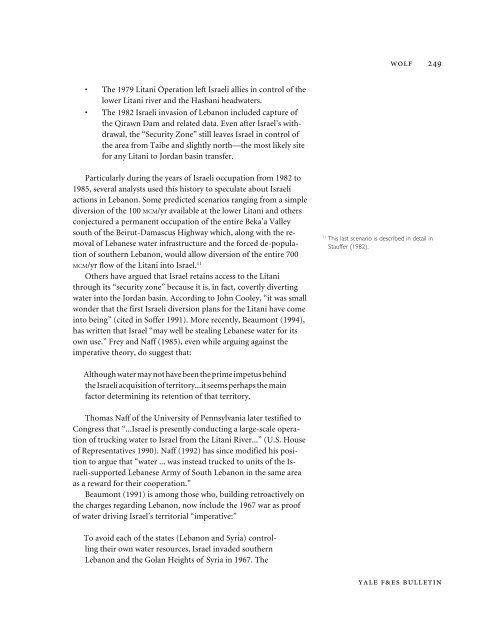Hydrostrategic Decisionmaking and the Arab ... - Yale University
Hydrostrategic Decisionmaking and the Arab ... - Yale University
Hydrostrategic Decisionmaking and the Arab ... - Yale University
You also want an ePaper? Increase the reach of your titles
YUMPU automatically turns print PDFs into web optimized ePapers that Google loves.
WOLF 249• The 1979 Litani Operation left Israeli allies in control of <strong>the</strong>lower Litani river <strong>and</strong> <strong>the</strong> Hasbani headwaters.• The 1982 Israeli invasion of Lebanon included capture of<strong>the</strong> Qirawn Dam <strong>and</strong> related data. Even after Israel’s withdrawal,<strong>the</strong> “Security Zone” still leaves Israel in control of<strong>the</strong> area from Taibe <strong>and</strong> slightly north—<strong>the</strong> most likely sitefor any Litani to Jordan basin transfer.Particularly during <strong>the</strong> years of Israeli occupation from 1982 to1985, several analysts used this history to speculate about Israeliactions in Lebanon. Some predicted scenarios ranging from a simplediversion of <strong>the</strong> 100 MCM/yr available at <strong>the</strong> lower Litani <strong>and</strong> o<strong>the</strong>rsconjectured a permanent occupation of <strong>the</strong> entire Beka’a Valleysouth of <strong>the</strong> Beirut-Damascus Highway which, along with <strong>the</strong> removalof Lebanese water infrastructure <strong>and</strong> <strong>the</strong> forced de-populationof sou<strong>the</strong>rn Lebanon, would allow diversion of <strong>the</strong> entire 700MCM/yr flow of <strong>the</strong> Litani into Israel. 11O<strong>the</strong>rs have argued that Israel retains access to <strong>the</strong> Litanithrough its “security zone” because it is, in fact, covertly divertingwater into <strong>the</strong> Jordan basin. According to John Cooley, “it was smallwonder that <strong>the</strong> first Israeli diversion plans for <strong>the</strong> Litani have comeinto being” (cited in Soffer 1991). More recently, Beaumont (1994),has written that Israel “may well be stealing Lebanese water for itsown use.” Frey <strong>and</strong> Naff (1985), even while arguing against <strong>the</strong>imperative <strong>the</strong>ory, do suggest that:11This last scenario is described in detail inStauffer (1982).Although water may not have been <strong>the</strong> prime impetus behind<strong>the</strong> Israeli acquisition of territory...it seems perhaps <strong>the</strong> mainfactor determining its retention of that territory.Thomas Naff of <strong>the</strong> <strong>University</strong> of Pennsylvania later testified toCongress that “...Israel is presently conducting a large-scale operationof trucking water to Israel from <strong>the</strong> Litani River...” (U.S. Houseof Representatives 1990). Naff (1992) has since modified his positionto argue that “water ... was instead trucked to units of <strong>the</strong> Israeli-supportedLebanese Army of South Lebanon in <strong>the</strong> same areaas a reward for <strong>the</strong>ir cooperation.”Beaumont (1991) is among those who, building retroactively on<strong>the</strong> charges regarding Lebanon, now include <strong>the</strong> 1967 war as proofof water driving Israel’s territorial “imperative:”To avoid each of <strong>the</strong> states (Lebanon <strong>and</strong> Syria) controlling<strong>the</strong>ir own water resources, Israel invaded sou<strong>the</strong>rnLebanon <strong>and</strong> <strong>the</strong> Golan Heights of Syria in 1967. TheYALE F&ES BULLETIN
















